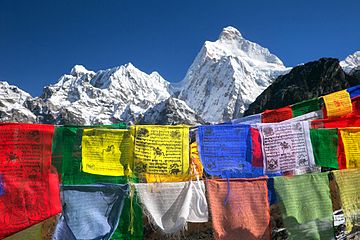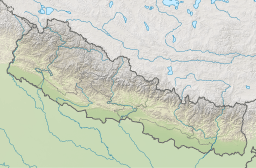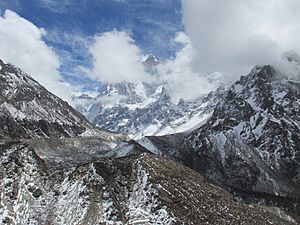Kumbhakarna Mountain facts for kids
Quick facts for kids Kumbhakarna |
|
|---|---|
| Jannu | |

Jannu from the south
|
|
| Highest point | |
| Elevation | 7,710 m (25,300 ft) Ranked 32nd |
| Prominence | 1,035 m (3,396 ft) |
| Listing | List of mountains in Nepal |
| Geography | |
| Location | Eastern Nepal |
| Parent range | Himalayas |
| Climbing | |
| First ascent | April 27–28, 1962 by René Desmaison, Paul Keller, Robert Paragot, Gyalzen Mitchung Sherpa, Lionel Terray, André Bertraud, Jean Bouvier, Pierre Leroux, Yves Pollet-Villard, Jean Ravier and Wangdi Sherpa |
| Easiest route | rock/snow/ice climb |
Mount Kumbhakarna, also known as Jannu, is a huge mountain in the Himalayas. It's the 32nd highest mountain in the world! This amazing peak is located in eastern Nepal. It stands near Kangchenjunga, which is the third-highest mountain on Earth.
Kumbhakarna is a very tall and steep mountain. It has many difficult paths for climbers. Its official name is Kumbhakarna. But many people still call it Jannu. In the Limbu language, it's called Phoktanglungma. This means "mountain with shoulders." It is a sacred place in the Kirant religion.
Contents
Where is Mount Kumbhakarna?
Kumbhakarna is the tallest peak in its part of the Kangchenjunga Himal mountain range. This area is right on the border between Nepal and Sikkim. But Kumbhakarna itself is completely inside Nepal. A long ridge connects it to Kangchenjunga in the east.
What makes Kumbhakarna special?
Kumbhakarna is the 32nd highest mountain in the world. It is known for being a very tough climb. It's one of the hardest peaks to climb because of its tricky shape. The mountain has very steep sections. The climbing near the top is especially difficult.
The north face of Kumbhakarna is very famous. It's sometimes called the "Wall of Shadows." This side of the mountain has seen some of the most challenging climbs ever. These climbs happen at very high altitudes, over 7,000 meters (about 23,000 feet).
Who first climbed Kumbhakarna?
People first explored Kumbhakarna Jannu in 1957. A French team tried to climb it in 1959. The mountain was first successfully climbed in 1962. A team led by French climber Lionel Terray made the first ascent.
The first climbers to reach the top were:
- René Desmaison
- Paul Keller
- Robert Paragot
- Gyalzen Mitchung Sherpa (on April 27)
- Lionel Terray
- André Bertraud
- Jean Bouvier
- Pierre Leroux
- Yves Pollet-Villard
- Jean Ravier
- Wangdi Sherpa (on April 28)
Their path started from the Yamatari Glacier. This glacier is south of the peak. They followed a winding route to a large flat area. This area is called the Throne. It's a glacier hanging south of the summit. From there, they continued to the top using the southeast ridge.
The huge north face was first climbed in 1976. A Japanese team led by Masatsugu Konishi achieved this. They climbed the left side of the face. They then met the east ridge. This helped them avoid the steepest part near the top.
In 2004, a Russian team successfully climbed the direct north face. This was a huge achievement. It required special climbing techniques. They had to use ropes and equipment to climb very steep rock walls. This was done at over 7,500 meters (about 24,600 feet). The team won a special award called the Piolet d'Or for their climb.
The Himalayan Index lists more than a dozen successful climbs of Jannu. There might be even more climbs that haven't been officially written about.
Gallery
See also
 In Spanish: Jannu para niños
In Spanish: Jannu para niños





